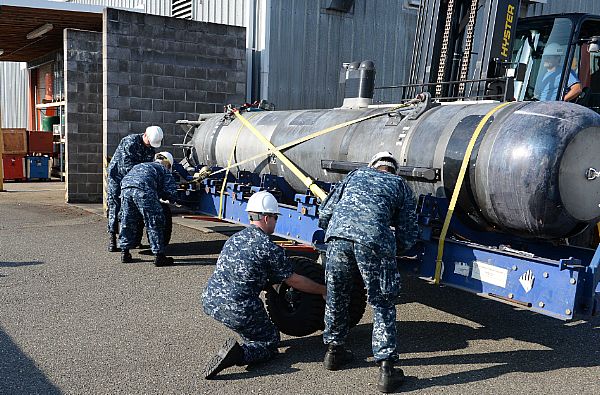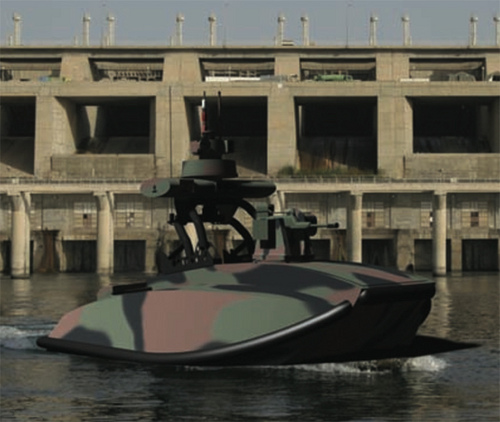US Navy image of a Penn State ARL developed Sea Stalker large-diameter unmanned underwater vehicle (LDUUV).
---
The current status of UUVs in the US Navy paints a confusing picture. Perhaps such confusion is intentional for security and commercial competition reasons. There are small UUVs, medium size torpedo tube fitting UUVs (like the Bluefin-21 deployed by the US Navy in search of Malaysian Airlines MH370 off Western Australia). Then there are LDUUVs. The US Navy is learning what to ask for in LDUUV requirements by simultaneously testing LDUUVs like the Sea Stalker.
There may be widely varying degrees of remote control and autonomy of LDUUVs. LDUUVs might increasingly be used in littoral waters too shallow for full sized submarines or full sized high value warships. LDUUVs might also be used for missions too dangerous due to high possibilities of detection by anti-submarine or anti-shipping forces (eg. defending foreign submarines, ships, aircraft, anti-ship missiles etc).
The ability of a surface ship to deploy a LDUUV potentially permits that ship to have some of the intelligence gathering and weapons capabilities of a submarine. By weapons that might mean an LDUUV attaching small limpet mines to ships in harbour or an entire LDUUV exploding under a high value ship in harbour or other chokepoint.
LDUUVs as CABLE TAPPERS
The following is a logical outgrowth of the publication decades ago of undersea cable tapping under Operation Ivy Bells http://en.wikipedia.org/wiki/Operation_Ivy_Bells Also see the Wikipedia entry on modified Seawolf-class SSN USS Jimmy Carter"Past submarines outfitted this way were used to tap undersea cables, to intercept communications of foreign countries." It is therefore assumed undersea cable tapping remains a reality.
For the delicate task of tapping undersea fibre-optic cables LDUUV's offer advantages over medium-large submarines (close to cables) or divers.
LDUUVs:
- being without a crew are semi-deniable (unlike manned submarine crews and divers they cannot be questioned in front of the world media)
- do not involve friendly deaths or risk of injury
- may be capable of far deeper operation (1,000s meters?) than manned submarines and divers. LDUUVs could operate at or beyond estimated "crush depth" as there is no crew at risk
- if the capture of a LDUUV is imminent remotely initiated or autonomous destruction could take place (of electronics, including hard-disc records and other high technology). The whole LDUUV could also self-destruct (preferably keeping would-be capturers at a safe distance)
- are potentially of shallow water tapping in the littorals (too shallow)
- can operate in areas too dangerous or too politically sensitive for manned submarines
- would present a far lower sonic, visual and magnetic signature (and other emissions) than a manned submarine (thus reducing detectability)
- can utilise their thrusters and specialised splicing technology for tapping or other work
- are less likely to damage or break a cable, by mistake, than a much larger submarine attempting to work on a cable directly
- not only submarines could operate, release and retrieve LDUUVs but mine-sweepers on up in a navy or more delicately large "trawlers" on up in commercial shipping terms
- are not restricted to the US Navy or other agencies but LDUUVs may be possessed by foreign navies and agencies such as those of Russia (near Stockholm in late 2014?) and China.
SEA STALKER LDUUV DETAIL
The US Navy appears to be sponsoring the development of LDUUVs by private companies and academic institutions while it sets requirements for upgraded LDUUV technology. The Navy's approach is pragmatic. It is difficult to set requirement for a technology if one does not have some idea of its ever greater practical capabilities.
Since conducting a 2006 study, the US Navy has been developing requirements for submarine-deployable LDUUVs with payload capabilities much greater than the limitations posed by medium sized UUVs (that can fit in 533mm (21 inch) diameter torpedo tube). Examples of medium sized UUVs are the Bluefin-21 (hence 21 inch - which transmits data to the mother ship or sub) or upgraded Mark 48 torpedos (which carry sensors for data transmission).
The Sea Stalker is a 38-inch (0.97m) diameter platform with a speed of nearly 5 knots. The US Navy has conducted some experimentation with the Sea Stalker UUV, a development of the Sea Horse UUV built by the Pennsylvania State University Applied Research Laboratory (ARL).
In August 2014, the Sea Stalker was delivered to Naval Undersea Warfare Center Keyport, Washington state (northwestern USA) to be employed by Commander, Submarine Development Squadron FIVE, Detachment UUV for capabilities testing and proficiency training in preparation for the delivery of future large diameter UUVs.
On November 25, 2014 US Naval Sea Systems Command (with Sea Stalker, other public LDUUVs and covert LDUUVs in mind) released a refined draft of top-level requirements. The requirements or instructions were:
"The Increment 1 LDUUV will have mission capabilities to include Intelligence Preparation of the Operational Environment and below-water Intelligence Surveillance Reconnaissance to improve battlespace awareness. [Increment 1] will be capable of launch and recovery by...Virginia-class submarines [by] Virginia Payload Modules or Modernized-Dry Deck Shelter."
The Sea Stalker may already have been tested (as Large Training Vehicle 38) including:
- launched and recovery from the USS Bainbridge (DDG-96), and
- launch and retrieval using the dry-deck shelter of an Ohio-class SSGN submarine and modified SSN USS Jimmy Carter?.
Sea Stalker can be powered by a lithium battery when operated from US surface ships with an endurance of seven to 10 days. On submarines it may currently only use alkaline (D-Cell) batteries (for safety reasons?) in which case its endurance may only be three days. It can loiter offshore, [and in-harbour (etc?)] collecting intelligence with two antenna masts, transmit and receive information via an Iridium satellite or (presumably) other US satellites. It is also useful for command and control [of what? special forces? other LDUUVs?].
- launch and retrieval using the dry-deck shelter of an Ohio-class SSGN submarine and modified SSN USS Jimmy Carter?.
Sea Stalker can be powered by a lithium battery when operated from US surface ships with an endurance of seven to 10 days. On submarines it may currently only use alkaline (D-Cell) batteries (for safety reasons?) in which case its endurance may only be three days. It can loiter offshore, [and in-harbour (etc?)] collecting intelligence with two antenna masts, transmit and receive information via an Iridium satellite or (presumably) other US satellites. It is also useful for command and control [of what? special forces? other LDUUVs?].
----
(Sea Stalker) AUV System Spec Sheet
[Base] Platform: Seahorse
Developer and Manufacturer: Pennsylvania State University Applied Research Laboratory
Sources
Autonomous Underwater Vehicles Application Center reports http://auvac.org/people-organizations/view/244 and http://auvac.org/configurations/view/202
On requirements and some physical realities SEAPOWER Magazine, December 1, 2014 reports http://www.seapowermagazine.org/stories/20141201-lduuv.html:
navaldrones.com reports http://www.navaldrones.com/Sea-Stalker-UUV.html:
SEA STALKER USV
The Sea Stalker USV is a robot boat developed by General Dynamics Robotic Systems (GDRS) and associated companies - see http://www.navaldrones.com/Sea-Stalker-USV.html. The Sea Stalker USV is a 5 meter unmanned surface vehicle (robot boat). Sea Stalker can deploy the even smaller 1.5 meter RiverRat recon craft.
---
---
FINAL COMMENT (STOCKHOLM)
LDUUVs are probably capable of deep or shallow water cable tapping and attaching small mines to ships.
Other types of intelligence gathering are possible. For example if a mission payload module includes specialised antennas then targetted interception of limited frequencies in an adjacent city may also be possible. The late 2014 publicised sighting (and sonaring) of a suspected Russian mini-submarine just off Stockholm (Sweden) may be a case of such activity. See this blog's post of January 15, 2015 on the Stockholm mini-submarine or LDUUV issue.
Pete


















